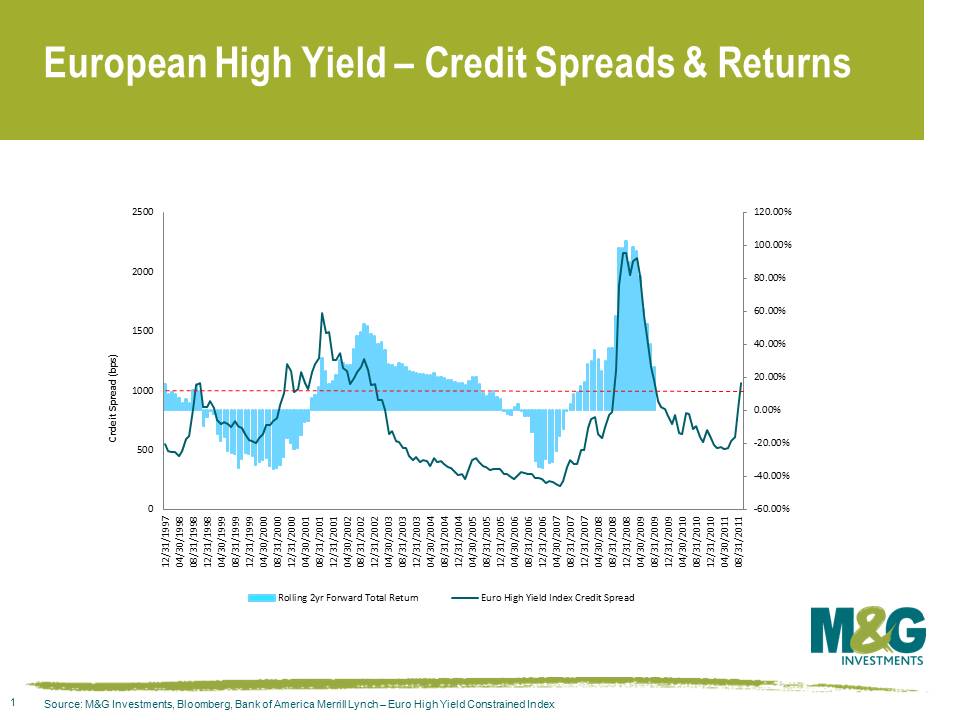European High Yield – Crossing the Value Rubicon
As we’ve stated earlier this year, we think the European high yield market is presenting us with some very interesting opportunities. As of 6th October, one of the high yield indices that we track had an average yield to maturity of 12.0%. This equates to a risk premium above and beyond government bonds of around 10.4%, a level that we believe more than compensates investors for expected default risk over the next few years. To put it bluntly, we think high yield bonds are cheap. However, this always begs the (very valid) rejoinder: “Sure it’s cheap, but can it get cheaper?”
The age old problem is that investors can be duped by optically cheap valuations only to lose money as the market continues to re-price lower. Timing, at the end of the day, is still a very important consideration. Unfortunately for investors, timing is also one of the hardest things to get right. The best that most humble fund mangers can hope for is that the valuation case is so compelling that the potential upside over the medium term can cushion or outweigh any timing errors in the short term.
It was with this in mind that I took a look at the last two market cycles within the European high yield market to investigate the potential medium term impact of any so-called timing errors. The results were intriguing.
What the chart shows below is the credit spread of a Merrill Lynch High Yield Index on the left hand side (the additional yield above government bonds shown in 1,000th’s of a %). On the right hand side, the bars up and down show the rolling return over the next 2 years.

Focusing above the dotted red line, when credit spreads are over 10% (or when valuations suggest the market is cheap) the chart shows us that investing in the high yield market early in the TMT/Dot Com sell off of 2000/2001 would have led to negative returns over the next 2 years. Consequently, the chances of making a timing error were present early in the cycle despite the attractive valuations. The key reason, in my view, was the length and nature of the ensuing default cycle over the following 2 years. This was a fairly brutal default cycle, particularly for the telecommunications and cable sectors. Also, credit spreads remained elevated for quite a long time which denied investors the following wind of falling risk premia. Nevertheless, buying into the high yield market when spreads were over 10% would have generated attractive returns over the following 2 years roughly 75% of the time.
Contrast this to the post-Lehman sell off. Even though spreads peaked at far higher levels than 10%, the scope for making a “timing error” was literally zero using the same criteria. Total returns over the next 2 years were both consistently positive and high when credit spreads were over 10%. The key driver behind this is twofold. Firstly, the default cycle post-Lehman was fairly short and sharp and the sector with the highest default rate was banking & finance (not traditionally a large component of the high yield market). Secondly, the speed and scale of the market recovery meant total returns were particularly high in the following 2 years (rapidly falling credit spreads mean rapidly rising bond prices). Consequently, the lack of an extended default cycle coupled with a rapid recovery in risk premia generated some very high returns.
What does this mean for the European high yield market now we have crossed the Rubicon of 10% credit spreads once more? Are we set for a long drawn-out default cycle, or a short and rapid snap back in spreads that will swamp any timing error? I believe the answer lies in the nature of the next default cycle.
For what it’s worth here are my thoughts:
1) The default cycle will weigh most heavily upon sovereign issuers and banks (this is already happening).
2) I do not think we will see a rapid, sharp fall in risk premia to match the 2009 rally. Policy options this time around are more limited and fiscal constraints more acute.
3) There is some scope for a long drawn-out default cycle – but the risks will be concentrated in the European periphery (fiscal retrenchment and de-leveraging creates a hostile environment for highly leveraged companies exposed to these economies).
If I’m right, the next default cycle will present us with some clear cut opportunities and risks. The risk of “timing errors” is arguably highest within the financial sector and the European periphery. These areas could still present great opportunities in due course, but for now I’d argue that investors need to tread with caution. Go in too early and you run the risk of being swamped by a long drawn-out default cycle, despite optically attractive valuations.
On the other hand, the opportunities in European high yield away from these areas are plentiful. I believe the default cycle for the non-financial and non-peripheral issuers will be much more benign. Accordingly, the scope for so called “timing errors” is greatly diminished and this is where investors can cross the European High Yield Rubicon with much greater confidence.
The value of investments will fluctuate, which will cause prices to fall as well as rise and you may not get back the original amount you invested. Past performance is not a guide to future performance.


18 years of comment
Discover historical blogs from our extensive archive with our Blast from the past feature. View the most popular blogs posted this month - 5, 10 or 15 years ago!


Bond Vigilantes
Get Bond Vigilantes updates straight to your inbox





